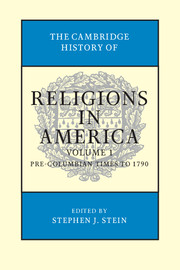Book contents
- Frontmatter
- Contents
- Contributors
- Editor's Introduction
- SECTION I BACKGROUND ON RELIGIOUS TRADITIONS – PRE-1500S
- SECTION II RELIGIONS IN THE POST-COLUMBIAN NEW WORLD – 1500–1680S
- 6 Iroquoian Religion during the Seventeenth Century
- 7 Mississippian Religious Traditions
- 8 The Anasazi
- 9 Spanish Catholicism in the Era of Exploration and Early Colonization
- 10 French Catholicism in the Era of Exploration and Early Colonization
- 11 English, Dutch, and Swedish Protestantism in the Era of Exploration and Early Colonization
- SECTION III RELIGIOUS PATTERNS IN COLONIAL AMERICA – 1680S–1730S
- SECTION IV RELIGIOUS DIVERSITY IN BRITISH AMERICA – 1730S–1790
- SECTION V AMERICAN RELIGIONS IN THE EIGHTEENTH-CENTURY INTERNATIONAL CONTEXT
- SECTION VI THEMATIC ESSAYS
- Index
- References
8 - The Anasazi
from SECTION II - RELIGIONS IN THE POST-COLUMBIAN NEW WORLD – 1500–1680S
Published online by Cambridge University Press: 28 July 2012
- Frontmatter
- Contents
- Contributors
- Editor's Introduction
- SECTION I BACKGROUND ON RELIGIOUS TRADITIONS – PRE-1500S
- SECTION II RELIGIONS IN THE POST-COLUMBIAN NEW WORLD – 1500–1680S
- 6 Iroquoian Religion during the Seventeenth Century
- 7 Mississippian Religious Traditions
- 8 The Anasazi
- 9 Spanish Catholicism in the Era of Exploration and Early Colonization
- 10 French Catholicism in the Era of Exploration and Early Colonization
- 11 English, Dutch, and Swedish Protestantism in the Era of Exploration and Early Colonization
- SECTION III RELIGIOUS PATTERNS IN COLONIAL AMERICA – 1680S–1730S
- SECTION IV RELIGIOUS DIVERSITY IN BRITISH AMERICA – 1730S–1790
- SECTION V AMERICAN RELIGIONS IN THE EIGHTEENTH-CENTURY INTERNATIONAL CONTEXT
- SECTION VI THEMATIC ESSAYS
- Index
- References
Summary
We do not even know what they called themselves. Certainly, they did not call themselves Anasazi. That is a name that the Athabaskan-speaking Navajo, who moved into their homeland and saw the monumental ruins of their settlements, gave to them. It is a term tinged with more than a hint of hostility. It is often translated “ancient strangers,” but it is more precisely rendered “ancient enemies” or “enemy ancestors” (annasázi, from anna' = enemy/stranger, and bizází = ancient/ancestor). They were the ancestors of the modern-day Pueblos. Their descendants most often call them simply “the ancient ones.” The Hopi, one of the tribal nations descended from them, term them hisatinom, “the ones who came before.” Understandably, given the etymology of the term “Anasazi,” contemporary Pueblos consider the term offensive. Today it is considered more precise and correct to refer to them as “Ancestral Puebloans” or “Ancient Puebloans.”
Despite the pejorative connotations of their most familiar appellation, no indigenous people in the Americas has been more romanticized than the “Anasazi.” Given this and the fact that they disappeared before the coming of Europeans to North America, is it possible to say anything about their religious beliefs and practices? The answer is a definite (but cautious) “Yes.”
There are thousands of years of Native American habitation in the Americas prior to European contact that can only be known in two ways: archaeology and oral tradition. For groups like the Ancestral Puebloans, there is only archaeology and the oral tradition of others. Archaeology is excellent at helping us discover the material world. It can tell us what a given people’s houses were like, what they ate, their level of health, and many other tangible things.
- Type
- Chapter
- Information
- The Cambridge History of Religions in America , pp. 156 - 176Publisher: Cambridge University PressPrint publication year: 2000



